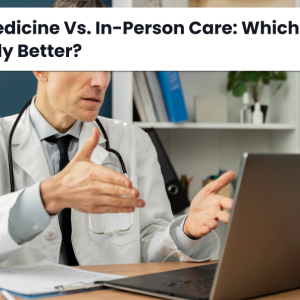
How Virtual Healthcare is Closing the Gap for Rural Patients
Accessing healthcare has always been tough for people living in rural areas of Canada and the USA. Long distances to hospitals, fewer doctors, and limited facilities make it challenging to get the care they need.
Thanks to telemedicine, things are changing. Using technology like video calls, phone consultations, and secure messaging, telemedicine is bringing virtual healthcare to people in remote areas. This means they can now connect with doctors and specialists without traveling long distances.
Let’s explore how telemedicine is solving healthcare issues in rural areas and making a real difference.
What Are the Challenges in Rural Healthcare?
In rural parts of Canada and the USA, there are fewer clinics, hospitals, and healthcare providers. This means people often have to drive for hours to see a doctor. The situation gets worse when they need to see a specialist, like a cardiologist or neurologist.
These challenges lead to delays in care. People in rural areas have higher chances of living with untreated chronic illnesses like diabetes or heart disease. Mental health care is also hard to access in these areas due to stigma and lack of resources.

How Telemedicine Is Bridging the Gap
Telemedicine is a game-changer for rural healthcare. With tools like video consultations and remote monitoring devices, it allows patients to connect with doctors without leaving their homes. Let’s look at some of its key benefits:
1. Easier Access to Specialists
In rural areas, getting an appointment with a specialist is tough. But telemedicine makes it possible.
For example, a person in a small town in Alberta can now have a virtual consultation with a specialist in Toronto. Similarly, someone in rural Texas can speak with a top cardiologist in New York through a video call. This saves time, money, and energy while ensuring the patient gets the care they need.
2. Faster Diagnoses and Treatments
In rural areas, delays in care can make illnesses worse. Telemedicine allows patients to consult doctors quickly, leading to faster diagnoses and treatments.
For example, someone with high blood pressure can get advice on managing it during a virtual check-up instead of waiting weeks for an in-person appointment.
3. Better Care for Chronic Illnesses
Many people in rural areas live with chronic conditions like diabetes or asthma. Telemedicine helps them manage their health by allowing regular check-ins with doctors without traveling.
Devices like blood pressure monitors or glucose meters can send data directly to the doctor, so they can adjust treatments as needed. This keeps patients healthier and prevents complications.
4. Access to Mental Health Care
Mental health care is often ignored in rural areas due to stigma or lack of services. Telemedicine makes it easier for people to access virtual counseling or therapy sessions.
For someone dealing with anxiety or depression, being able to talk to a therapist online can make a huge difference. It’s private, convenient, and effective.
5. Emergency Support
In emergencies, telemedicine can save lives. For example, a small clinic in a rural town can connect with specialists in a big city to get advice on treating stroke patients.
This ensures quick, informed decisions during critical situations.
The Future of Telemedicine
Telemedicine is making healthcare accessible and convenient for rural communities in Canada and the USA. While there are still challenges like internet connectivity and affordability, advancements in technology are helping overcome these barriers.
By providing faster care, better access to specialists, and support for chronic illnesses and mental health, telemedicine is improving the lives of rural residents. It’s clear that the future of healthcare is digital, and telemedicine is leading the way.
Key Takeaways
- Telemedicine helps rural communities connect with doctors and specialists without traveling.
- It offers better care for chronic illnesses and mental health conditions.
- It saves time, money, and lives, especially during emergencies.
- With advancements in technology, telemedicine will continue to grow and benefit even more people.
In summary
By facilitating access to specialists, accelerating diagnosis, enhancing the management of chronic illnesses, and providing mental health services, telemedicine is completely transforming rural healthcare in both Canada and the United States. Even if issues like cost and internet connection still exist, telemedicine in remote areas has a bright future since ongoing technical developments will make healthcare even more accessible. Rural residents may now get the care they require, whenever they need it, no matter where they live, thanks to telemedicine.





